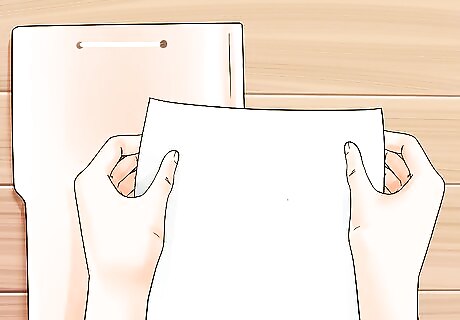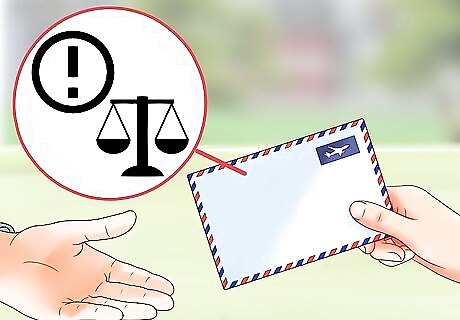
views
X
Research source
Filing a Notice of Claim

Contact the appropriate agency. Since different departments or agencies may have their own procedures, you should first get in touch with the department or agency you believe is responsible for your damages or injuries. Explain to the agent with whom you speak that you want to file a claim against the local government. He or she may ask you questions about what happened. If another office or agency is better suited to take your claim, he or she will direct you there. Keep in mind that most state and local governments have short time limits for you to file a claim. There are deadlines, called statutes of limitations, that apply to all personal injury lawsuits, and typically give you between one and six years to file a lawsuit after your injury happens. However, you may have a shorter period of time to file a claim against a state or local government agency. In some areas, you must file your claim with the agency within 30 days of the date you were injured. For this reason, it's important that you contact the agency as soon as possible after the incident so you can preserve your right to sue for damages. If you miss the deadline – either because you were unable to file a claim or because you didn't realize a government entity was possibly responsible until some time after the incident – you still may be able to file a claim, provided you can show a good reason for the delay. If you believe the deadline has already passed or will soon pass, you may want to consult an attorney on your options for filing a late claim.

Fill out a claim form. Typically the agency you contact will have a standard form you must fill out to provide the agency with notice of your claim and describe the incident that occurred. Your city may have claim forms available online. More typically, though, you'll have to make a trip to the city clerk's office to pick up a paper form. The form will require you to provide personal information about yourself, as well as the incident that occurred and what you did afterward, in terms of medical treatment you received and the like. You can still file a claim even if the agency doesn't have a specific form. In this case, you may need to write a letter to the agency asserting your claim. Contact your city or county clerk's office and find out what information must be included in your letter.

Include facts and damages. Make sure you include specific facts and details about the incident that gave rise to your claim on your form, including the date and time of the incident and the names of any government employees involved. At a minimum, make sure you have the correct date and at least an approximate time when the incident took place. Provide specific street addresses and locations where the incident occurred. If there's any information you don't know, but believe is important, state that you don't know the information – don't guess. Names of any government employees with whom you interacted before, during, or after the incident are important, but if you didn't write them down or commit them to memory, simply say you don't know. For example, if you don't know the name of a city employee who helped you at the scene of the incident, state in your claim that someone helped you, but that you don't know his or her name. You also must include a specific amount of money you are claiming in damages. Total your medical bills and any lost wages, but the amount you list on your claim form should be more than the exact amount your claim is actually worth. Keep in mind that if the city agrees to pay, it typically will present a settlement offer that is lower than the amount for which you asked, so you want to leave room for that.

Submit your claim. When you've finished filling out your claim form, make a copy of it for your records and then give it to the right person or officer according to the procedure laid out by the agency or department. Local governments have specific agencies which must be given notice of your claim, which means you may need to submit copies of your claim to more than one place. In some jurisdictions, you also must send a copy of your claim to any government employees who you've listed by name as responsible for your injuries or property damage. You may be able to find information at your city or county government's website about where to submit claims, but typically you should call the city or county clerk's office. Tell the clerk you have a personal injury or property damage claim form to submit, and he or she will let you know where the form must be sent. You may want to drop your claim off in person, but if you mail it, make sure you use certified mail with returned receipt requested. That way you'll have proof of when the agency receives form.

Wait for a response. Typically the agency will investigate your claim after receiving it, during which time you may be contacted by a government agent or attorney with any questions. Then the agency will issue a decision of whether to accept or deny your claim. Agencies have a period of time to respond after you've submitted your claim, typically between 30 and 120 days. If that period lapses and you receive no response, you are free to file a lawsuit. If the agency accepts your claim, you'll receive a notice that includes an amount the agency is willing to pay. If you agree to that amount (although it may be less than what you originally asked for), you can let the agency know and it will send you a check. You can always reject the agency's settlement offer, in which case you also will receive a notice that you have the right to file a lawsuit. The agency also will send you a notice if it rejects your claim. At this point, you have a limited period of time, typically six months or so, to file a lawsuit against the agency. When you receive a denial notice or other letter telling you that you have the right to file a lawsuit, keep the original and make copies. You typically will need to file a copy of the notice along with your lawsuit.
Initiating Your Lawsuit

Consider consulting an attorney. Although if you've decided to file your lawsuit in small claims court you typically won't need to hire an attorney, you may want to at least talk to someone to get advice on your case before proceeding. Personal injury attorneys typically give free initial consultations, and often will represent you on a contingency basis, meaning you won't have to pay attorney's fees unless you settle your case or win in court. Look for an attorney who specializes in personal injury lawsuits against the state or local government, because he or she will understand the conditions under which the government is not liable for your damages or injuries, and how to defeat those presumptions.

Choose the correct court. Typically you must file in the court in the same county where the incident occurred, or where the local government office is located. If you're filing in small claims court, your damages also must be under a certain maximum amount. Some states only allow lawsuits against local or state governments to be filed in particular courts. Your denial notice in response to your administrative claim typically will tell you where you may file a lawsuit. In some states, the maximum amount of damages for which you can sue in small claims court is relatively high – as much as $10,000 or $20,000. However, in other states the limit is set at only a few thousand dollars. If your claim is worth more than this, you'll have to file your lawsuit in state civil court.

Draft your complaint. Small claims courts typically have a basic form you can fill out to initiate your lawsuit. You can use much of the same information as you included on the claim form you filled out for the administrative department or agency. The small claims court may have a fillable form you can download from the court's website and fill out on your home computer, or you may have to go to the clerk's office to get a paper copy of the form. If you're filing in state civil court, contact the clerk's office and find out what forms or templates are available for complaints. Many state courts have a blank template you can use, although you'll have to include all the information necessary to state a legal claim. You must include factual allegations about the incident that caused your injuries or damage to your property, and include the amount of damages you believe you are owed as a result. If you consult an attorney, be sure to ask him or her what information you need to include in your legal complaint.

File your complaint. After you've finished your complaint, make one copy for your records and another to deliver to the government agency. Then take your original and copies to the clerk's office of the court where you want your lawsuit to be heard. When you file your complaint, you will have to pay filing fees to initiate your lawsuit. In a state civil court, these fees may amount to several hundred dollars, while in small claims court your filing fees typically will be around $100. If you believe you can't afford filing fees, ask the clerk for an application for a fee waiver. You must include information about your income and assets on the application. If they fall below the threshold set by your state's court system, you won't have to pay filing fees for your lawsuit. In most states, you're automatically eligible for a waiver if you receive public assistance. The clerk will stamp your original documents and all copies filed, then give the copies back to you. One of those copies will be for you, while the others must be delivered to the government agency or other offices required to receive notice of a lawsuit against the government.

Have the government served. Before a court will hear your case, your complaint must be delivered to the local government department or agency you're suing so it has sufficient legal notice of the lawsuit. Legal service typically is completed by having a sheriff's deputy or private process server hand-deliver your documents to the offices or individuals who must be notified of the lawsuit. After service is complete, the deputy completes a proof of service document that you must either file with the court or bring with you to your small claims hearing. In some jurisdictions, you also have the ability to serve a lawsuit using certified mail with returned receipt requested. The green receipt you get in the mail provides your proof that the documents were served, although typically you still must fill out a proof of service form. Certified mail may be cheaper and more convenient for you, particularly if you have to serve copies of the lawsuit to several different locations, offices, or individuals. Typically you must serve the specific agency you've named in your lawsuit, as well as any individual government employees you allege are responsible for your injuries or property damage. In many jurisdictions, you also must serve the city's attorney or the city or county clerk's office with a complaint and summons.
Litigating Your Case

Receive the government's response. After the agency or department has been served, it has a limited period of time to file an answer or other response to your complaint with the court if it wants to defend against your claim. If you filed your lawsuit in state civil court, the government may have as long as a month to respond to your lawsuit. However, small claims courts typically allow briefer periods of time for a response, sometimes only a couple of weeks. Often the government's response to your lawsuit will be to file an answer in which it denies most, if not all, of your allegations. This means you must prove each of those things at the hearing of your case. The government's answer also may include various defenses, or a motion to dismiss your lawsuit. In these cases, you may want to talk to an attorney about your options and what you must do to maintain your lawsuit. Keep in mind that to sue state or local government, you often must overcome a legal presumption that the government is immune to certain types of lawsuits. If the government has claimed immunity as a defense, you'll need to look up the particular law mentioned so you can figure out how to defeat that claim. Another option is that a government official may contact you with a settlement offer. This offer typically will be more than you were originally offered when you filed your administrative claim. If your administrative claim was denied, the government may be interested in settling now, although probably for a much smaller amount than you've requested in your complaint.

Conduct discovery. Through the discovery process, you and the government agency have the opportunity to exchange information and evidence relevant to the case. Most small claims courts don't provide this process, or only allow for limited written discovery. Written discovery typically consists of interrogatories, which are written questions for the other party to answer in writing under oath, and requests for production, through which one party asks the other for documents and other evidence that has relevance to the case. Often in small claims court you must ask the court permission before you exchange discovery documents with the government attorney. Discovery can be an important process for you, particularly if you are lacking details that could strengthen your evidence. For example, if you don't know the name of one of the government employees who you believe was responsible for your injuries, you may be able to find that out through discovery.

Attempt mediation. Some courts may offer mediation, which gives you an opportunity to work with a neutral third party skilled in alternative dispute resolution. He or she will facilitate a discussion between you and the government in an attempt to settle the case. You can find out at the clerk's office what mediation options are available in your jurisdiction. If you choose to attempt mediation, keep in mind that it is a voluntary procedure – both parties must agree to it before an appointment will be scheduled. Some courts offer free mediation for litigants. In other jurisdictions, there may be a small fee, which typically is split between the parties. The mediator won't resolve your case for you. You and a representative from the local government must negotiate and agree upon a settlement. If you are able to come to an agreement in mediation, the mediator typically will write up the terms of the settlement into a contract for both parties to sign. Attempting mediation does not mean you lose your right to a trial. If you are unable to come to a settlement through mediation, the court hearing will continue as scheduled.

Prepare for your hearing. If you are unable to reach a settlement through mediation, you must get your presentation and evidence ready so you can present your case to the judge. If you plan on calling witnesses, such as anyone who saw the incident that resulted in your injuries or property damage, you should get together with them at least once before the hearing and practice the questions you will ask them in court. Take notes about the incident that you can use when you present your case to the judge. Prepare and organize any evidence you have so you can introduce it at the appropriate time during your presentation. You may want to go to the courthouse before your hearing is scheduled and observe the court in session, particularly if you filed your lawsuit in small claims, so you have more of an understanding of the court's procedures and what is expected of litigants.




















Comments
0 comment